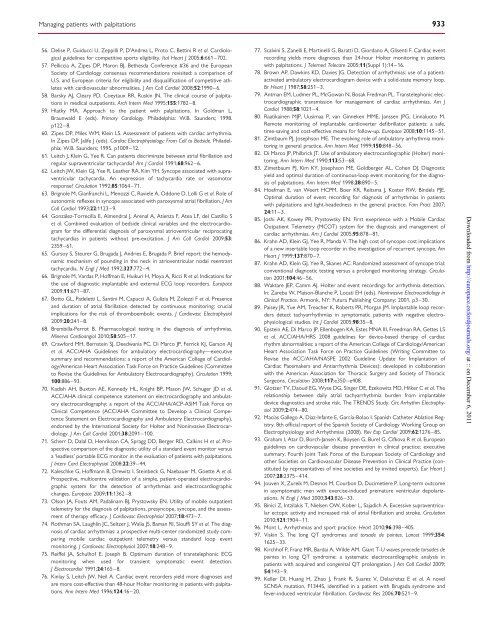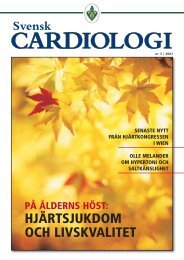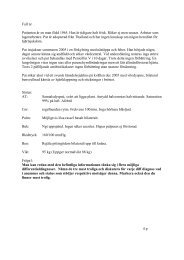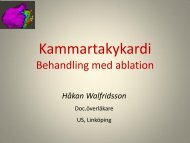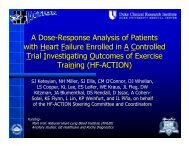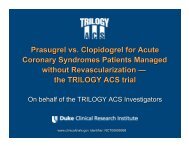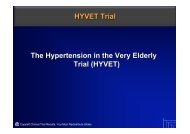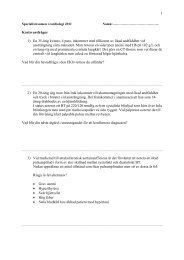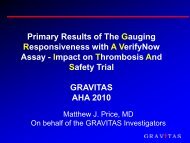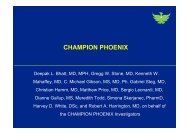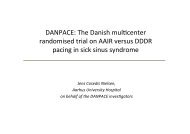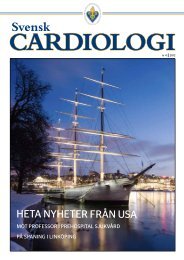Management of patients with palpitations: a position paper from the ...
Management of patients with palpitations: a position paper from the ...
Management of patients with palpitations: a position paper from the ...
Create successful ePaper yourself
Turn your PDF publications into a flip-book with our unique Google optimized e-Paper software.
Managing <strong>patients</strong> <strong>with</strong> <strong>palpitations</strong> 93356. Delise P, Guiducci U, Zeppilli P, D’Andrea L, Proto C, Bettini R et al. Cardiologicalguidelines for competitive sports eligibility. Ital Heart J 2005;6:661–702.57. Pelliccia A, Zipes DP, Maron BJ. Be<strong>the</strong>sda Conference #36 and <strong>the</strong> EuropeanSociety <strong>of</strong> Cardiology consensus recommendations revisited: a comparison <strong>of</strong>U.S. and European criteria for eligibility and disqualification <strong>of</strong> competitive athletes<strong>with</strong> cardiovascular abnormalities. J Am Coll Cardiol 2008;52:1990–6.58. Barsky AJ, Cleary PD, Coeytaux RR, Ruskin JN. The clinical course <strong>of</strong> <strong>palpitations</strong>in medical out<strong>patients</strong>. Arch Intern Med 1995;155:1782–8.59. Hlatky MA. Approach to <strong>the</strong> patient <strong>with</strong> <strong>palpitations</strong>. In Goldman L,Braunwald E (eds). Primary Cardiology. Philadelphia: W.B. Saunders; 1998.p122–8.60. Zipes DP, Miles WM, Klein LS. Assessment <strong>of</strong> <strong>patients</strong> <strong>with</strong> cardiac arrhythmia.In Zipes DP, Jalife J (eds). Cardiac Electrophysiology: From Cell to Bedside. Philadelphia:W.B. Saunders; 1995. p1009–12.61. Leitch J, Klein G, Yee R. Can <strong>patients</strong> discriminate between atrial fibrillation andregular supraventricular tachycardia? Am J Cardiol 1991;68:962–6.62. Leitch JW, Klein GJ, Yee R, Lea<strong>the</strong>r RA, Kim YH. Syncope associated <strong>with</strong> supraventriculartachycardia. An expression <strong>of</strong> tachycardia rate or vasomotorresponse? Circulation 1992;85:1064–71.63. Brignole M, Gianfranchi L, Menozzi C, Raviele A, Oddone D, Lolli G et al. Role <strong>of</strong>autonomic reflexes in syncope associated <strong>with</strong> paroxysmal atrial fibrillation. JAmColl Cardiol 1993;22:1123–9.64. González-Torrecilla E, Almendral J, Arenal A, Atienza F, Atea LF, del Castillo Set al. Combined evaluation <strong>of</strong> bedside clinical variables and <strong>the</strong> electrocardiogramfor <strong>the</strong> differential diagnosis <strong>of</strong> paroxysmal atrioventricular reciprocatingtachycardias in <strong>patients</strong> <strong>with</strong>out pre-excitation. J Am Coll Cardiol 2009;53:2359–61.65. Gursoy S, Steurer G, Brugada J, Andries E, Brugada P. Brief report: <strong>the</strong> hemodynamicmechanism <strong>of</strong> pounding in <strong>the</strong> neck in atrioventricular nodal reentranttachycardia. N Engl J Med 1992;327:772–4.66. Brignole M, Vardas P, H<strong>of</strong>fman E, Huikuri H, Moya A, Ricci R et al. Indications for<strong>the</strong> use <strong>of</strong> diagnostic implantable and external ECG loop recorders. Europace2009;11:671–87.67. Botto GL, Padeletti L, Santini M, Capucci A, Gulizia M, Zolezzi F et al. Presenceand duration <strong>of</strong> atrial fibrillation detected by continuous monitoring: crucialimplications for <strong>the</strong> risk <strong>of</strong> thromboembolic events. J Cardiovasc Electrophysiol2009;20:241–8.68. Brembilla-Perrot B. Pharmacological testing in <strong>the</strong> diagnosis <strong>of</strong> arrhythmias.Minerva Cardioangiol 2010;58:505–17.69. Crawford MH, Bernstein SJ, Deedwania PC, Di Marco JP, Ferrick KJ, Garson AJet al. ACC/AHA Guidelines for ambulatory electrocardiography—executivesummary and recommendations: a report <strong>of</strong> <strong>the</strong> American College <strong>of</strong> Cardiology/AmericanHeart Association Task Force on Practice Guidelines (Committeeto Revise <strong>the</strong> Guidelines for Ambulatory Electrocardiography). Circulation 1999;100:886–93.70. Kadish AH, Buxton AE, Kennedy HL, Knight BP, Mason JW, Schuger JD et al.ACC/AHA clinical competence statement on electrocardiography and ambulatoryelectrocardiography: a report <strong>of</strong> <strong>the</strong> ACC/AHA/ACP-ASIM Task Force onClinical Competence (ACC/AHA Committee to Develop a Clinical CompetenceStatement on Electrocardiography and Ambulatory Electrocardiography),endorsed by <strong>the</strong> International Society for Holter and Noninvasive Electrocardiology.J Am Coll Cardiol 2001;38:2091–100.71. Scherr D, Dalal D, Henrikson CA, Spragg DD, Berger RD, Calkins H et al. Prospectivecomparison <strong>of</strong> <strong>the</strong> diagnostic utility <strong>of</strong> a standard event monitor versusa ‘leadless’ portable ECG monitor in <strong>the</strong> evaluation <strong>of</strong> <strong>patients</strong> <strong>with</strong> <strong>palpitations</strong>.J Interv Card Electrophysiol 2008;22:39–44.72. Kaleschke G, H<strong>of</strong>fmann B, Drewitz I, Steinbeck G, Naebauer M, Goette A et al.Prospective, multicentre validation <strong>of</strong> a simple, patient-operated electrocardiographicsystem for <strong>the</strong> detection <strong>of</strong> arrhythmias and electrocardiographicchanges. Europace 2009;11:1362–8.73. Olson JA, Fouts AM, Padalinam BJ, Prystowsky EN. Utility <strong>of</strong> mobile outpatienttelemetry for <strong>the</strong> diagnosis <strong>of</strong> <strong>palpitations</strong>, presyncope, syncope, and <strong>the</strong> assessment<strong>of</strong> <strong>the</strong>rapy efficacy. J Cardiovasc Electrophsiol 2007;18:473–7.74. Rothman SA, Laughlin JC, Seltzer J, Walia JS, Baman RI, Siouffi SY et al. The diagnosis<strong>of</strong> cardiac arrhythmias: a prospective multi-center randomized study comparingmobile cardiac outpatient telemetry versus standard loop eventmonitoring. J Cardiovasc Electrophysiol 2007;18:248–9.75. Reiffel JA, Schulh<strong>of</strong> E, Joseph B. Optimum duration <strong>of</strong> transtelephonic ECGmonitoring when used for transient symptomatic event detection.J Electrocardiol 1991;24:165–8.76. Kinlay S, Leitch JW, Neil A. Cardiac event recorders yield more diagnoses andare more cost-effective than 48-hour Holter monitoring in <strong>patients</strong> <strong>with</strong> <strong>palpitations</strong>.Ann Intern Med 1996;124:16–20.77. Scalvini S, Zanelli E, Martinelli G, Baratti D, Giordano A, Glisenti F. Cardiac eventrecording yields more diagnoses than 24-hour Holter monitoring in <strong>patients</strong><strong>with</strong> <strong>palpitations</strong>. J Telemed Telecare 2005;11(Suppl 1):14–16.78. Brown AP, Dawkins KD, Davies JG. Detection <strong>of</strong> arrhythmias: use <strong>of</strong> a patientactivatedambulatory electrocardiogram device <strong>with</strong> a solid-state memory loop.Br Heart J 1987;58:251–3.79. Antman EM, Ludmer PL, McGowan N, Bosak Fredman PL. Transtelephonic electrocardiographictransmission for management <strong>of</strong> cardiac arrhythmias. Am JCardiol 1988;58:1021–4.80. Raatikainen MJP, Uusimaa P, van Ginneken MME, Janssen JPG, Linnaluoto M.Remote monitoring <strong>of</strong> implantable cardioverter defibrillator <strong>patients</strong>: a safe,time-saving and cost-effective means for follow-up. Europace 2008;10:1145–51.81. Zimtbaum PJ, Josephson ME. The evolving role <strong>of</strong> ambulatory arrhythmia monitoringin general practice. Ann Intern Med 1999;150:848–56.82. Di Marco JP, Philbrick JT. Use <strong>of</strong> ambulatory electrocardiographic (Holter) monitoring.Ann Intern Med 1990;113:53–68.83. Zimetbaum PJ, Kim KY, Josephson ME, Goldberger AL, Cohen DJ. Diagnosticyield and optimal duration <strong>of</strong> continuous-loop event monitoring for <strong>the</strong> diagnosis<strong>of</strong> <strong>palpitations</strong>. Ann Intern Med 1998;28:890–5.84. Hoefman E, van Weert HCPM, Boer KR, Reitsma J, Koster RW, Bindels PJE.Optimal duration <strong>of</strong> event recording for diagnosis <strong>of</strong> arrhythmias in <strong>patients</strong><strong>with</strong> <strong>palpitations</strong> and light-headedness in <strong>the</strong> general practice. Fam Pract 2007;24:11–3.85. Joshi AK, Kowey PR, Prystowsky EN. First exeprience <strong>with</strong> a Mobile CardiacOutpatient Telemetry (MCOT) system for <strong>the</strong> diagnosis and management <strong>of</strong>cardiac arrhythmias. Am J Cardiol 2005;95:878–81.86. Krahn AD, Klein GJ, Yee R, Manda V. The high cost <strong>of</strong> syncope: cost implications<strong>of</strong> a new insertable loop recorder in <strong>the</strong> investigation <strong>of</strong> recurrent syncope. AmHeart J 1999;137:870–7.87. Krahn AD, Klein GJ, Yee R, Skanes AC. Randomized assessment <strong>of</strong> syncope trial:conventional diagnostic testing versus a prolonged monitoring strategy. Circulation2001;104:46–56.88. Waktare JEP, Camm AJ. Holter and event recordings for arrhythmia detection.In: Zareba W, Maison-Blanche P, Locati EH (eds). Noninvasive Electrocardiology inClinical Practice. Armonk, NY: Futura Publishing Company; 2001. p3–30.89. Paisey JR, Yue AM, Treacher K, Roberts PR, Morgan JM. Implantable loop recordersdetect tachyarrhythmias in symptomatic <strong>patients</strong> <strong>with</strong> negative electrophysiologicalstudies. Int J Cardiol 2005;98:35–8.90. Epstein AE, Di Marco JP, Ellenbogen KA, Estes MNA III, Freedman RA, Gettes LSet al. ACC/AHA/HRS 2008 guidelines for device-based <strong>the</strong>rapy <strong>of</strong> cardiacrhythm abnormalities: a report <strong>of</strong> <strong>the</strong> American College <strong>of</strong> Cardiology/AmericanHeart Association Task Force on Practice Guidelines (Writing Committee toRevise <strong>the</strong> ACC/AHA/NASPE 2002 Guideline Update for Implantation <strong>of</strong>Cardiac Pacemakers and Antiarrhythmia Devices): developed in collaboration<strong>with</strong> <strong>the</strong> American Association for Thoracic Surgery and Society <strong>of</strong> ThoracicSurgeons. Circulation 2008;117:e350–e408.91. Glotzer TV, Daoud EG, Wyse DG, Singer DE, Ezekowitz MD, Hilker C et al. Therelationship between daily atrial tachyarrhythmia burden <strong>from</strong> implantabledevice diagnostics and stroke risk. The TRENDS Study. Circ Arrhythm Electrophysiol2009;2:474–80.92. Macías Gallego A, Díaz-Infante E, García-Bolao I. Spanish Ca<strong>the</strong>ter Ablation Registry.8th <strong>of</strong>ficial report <strong>of</strong> <strong>the</strong> Spanish Society <strong>of</strong> Cardiology Working Group onElectrophysiology and Arrhythmias (2008). Rev Esp Cardiol 2009;62:1276–85.93. Graham I, Atar D, Borch-Jansen K, Boysen G, Burel G, Cifkova R et al. Europeanguidelines on cardiovascular disease prevention in clinical practice: executivesummary. Fourth Joint Task Force <strong>of</strong> <strong>the</strong> European Society <strong>of</strong> Cardiology ando<strong>the</strong>r Societies on Cardiovascular Disease Prevention in Clinical Practice (constitutedby representatives <strong>of</strong> nine societies and by invited experts). Eur Heart J2007;28:2375–414.94. Jouven X, Zureik M, Desnos M, Courbon D, Ducimetiere P. Long-term outcomein asymptomatic men <strong>with</strong> exercise-induced premature ventricular depolarizations.N Engl J Med 2000;343:826–33.95. Binici Z, Intzilakis T, Nielsen OW, Kober L, Sajadich A. Excessive supraventricularectopic activity and increased risk <strong>of</strong> atrial fibrillation and stroke. Circulation2010;121:1904–11.96. Mont L. Arrhythmias and sport practice. Heart 2010;96:398–405.97. Viskin S. The long QT syndromes and torsade de pointes. Lancet 1999;354:1625–33.98. Kirchh<strong>of</strong> P, Franz MR, Bardai A, Wilde AM. Giant T-U waves precede torsades depointes in long QT syndrome: a systematic electrocardiographic analysis in<strong>patients</strong> <strong>with</strong> acquired and congenital QT prolongation. J Am Coll Cardiol 2009;54:143–9.99. Keller DI, Huang H, Zhao J, Frank R, Suarez V, Delacretaz E et al. A novelSCN5A mutation, F1344S, identified in a patient <strong>with</strong> Brugada syndrome andfever-induced ventricular fibrillation. Cardiovasc Res 2006;70:521–9.Downloaded <strong>from</strong> http://europace.oxfordjournals.org/ at :: on December 6, 2011


